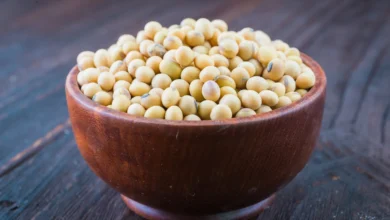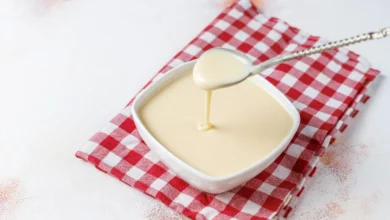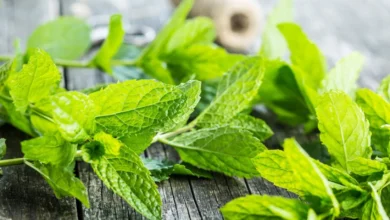Mint Alternatives: These Herbs Taste Just Like It!

Mint delivers a delightful burst of freshness to dishes and drinks. Whether you crave its vibrant sweetness in a dessert, its herbaceous kick in a savory dish, or the cool invigoration of a minty cocktail, this versatile herb adds a touch of magic. But what happens when fresh mint isn’t an option? Don’t worry – there’s a whole world of fantastic substitutes ready to step in!
Contents
- Substitutes for Mint
- Best Substitutes for Mint
- Substitution Table
- Reasons to Seek Mint Substitutes
- Substitute for Mint Leaves
- Dried Mint Substitute
- Important Considerations When Using Mint Substitutes
- Herbs that Mimic Mint’s Freshness
- Refreshing Citrusy Alternatives
- Lemon Verbena
- Frequently Asked Questions
- Can I use dried mint as a substitute for fresh mint leaves?
- Are there non-mint alternatives for mint flavor?
- What herbs work well in a mojito or mint julep besides mint?
- Is mint extract a good substitute for fresh mint leaves?
- How Do You Use Fresh Mint?
- What is the same as mint?
- What can you use instead of mint extract?
- What is a good substitute for mint in a cocktail?
- Can I substitute fresh mint for dried?
Substitutes for Mint
Fresh mint isn’t always available, you might have an allergy, or maybe you just want a different flavor. Whatever the reason, there are plenty of fantastic mint substitutes! Finding the right one depends on your recipe and desired taste. Get ready to discover exciting alternatives that will keep your cooking fresh and flavorful.
Best Substitutes for Mint
There’s no single “best” substitute for mint – it truly depends on your specific recipe and what flavor profile you’re trying to achieve.
- Fresh, vibrant flavor in a salad: Basil or cilantro can give you a similar herbaceous freshness.
- Hearty meat dish: Try a combination of rosemary and a pinch of dried mint for depth.
- Sweet treat: If available, chocolate mint is delightful, or basil can work in a pinch.
- Chocolate Mint: Adds a fun twist to desserts and drinks with its naturally sweet and minty profile.
- Tzatziki: If you enjoy a milder, slightly sweeter flavor, dill is a classic substitute for mint in tzatziki. Use a small amount initially and adjust to taste.
- Biryani: While mint is a classic in biryani, if you’re out, a small amount of dried mint or a combination of fresh coriander and parsley can provide a similar herbaceous note.
- Lemon Verbena: Offers a bright, citrusy flavor with subtle herbal notes.
- Lemon Balm: Provides a mild sweetness and a refreshing lemony taste.
- Tarragon: Brings a slightly licorice-like flavor, perfect for savory dishes.
- Arugula: A peppery and slightly bitter option that can add a unique complexity to salads or sauces.
Remember: All of these alternatives should be used in varying quantities depending on your taste! Start with less than you think you need and adjust to achieve the perfect flavor balance.
Substitution Table
| Substitute | Flavor Profile | Best Uses |
|---|---|---|
| Basil | Sweet, slightly peppery | Savory dishes, sauces, salads |
| Lemon Balm | Mildly sweet, lemony | Desserts, beverages, fruit salads |
| Cilantro | Fresh, citrusy, slightly soapy | Asian and Latin American cuisine |
| Tarragon | Hint of licorice, savory | Chicken, fish, egg dishes |
Reasons to Seek Mint Substitutes
- Allergies: Some individuals may have sensitivities or allergies to mint, necessitating alternative flavorings.
- Seasonal Shortages: Fresh mint can be harder to find out of season. Having a selection of substitutes on hand ensures you can still add the desired flavor notes to your recipes.
- Flavor Exploration: Experimenting with different substitutes allows you to discover new and exciting taste combinations in your cooking.
Substitute for Mint Leaves
Finding the perfect substitute for fresh mint leaves depends on what you’re making! Here’s a closer look at your best options with some ideas on how to use them:
- Flat-leaf parsley: Parsley is a versatile substitute for fresh mint. Although it doesn’t have a strong minty flavor, it adds a pop of color and freshness without overwhelming your dish. Perfect for herbed tahini sauce or mixed with dill.
- Cilantro: Also known as coriander, cilantro boasts a fresh, vibrant, and slightly citrusy flavor. It’s a good replacement for mint in savory dishes, salads, and sauces like chimichurri.
- Basil: Basil and mint are both fresh, vibrant herbs that can be substituted in many dishes. Basil can enhance the flavor of various recipes, especially savory dishes like pasta, salads, drinks, and even desserts.
- Thyme: Mint can be replaced with thyme in salads (think dressing!) and various dishes. It’s available both fresh and dried, serving as a versatile alternative.
- Dried mint: If you’re out of fresh mint, dried mint is your best bet! Use it in salad dressings or a marinade, just keep in mind the flavor is stronger. It’s always handy to have this in your spice rack.
- Chocolate mint: This variety is perfect for sweet treats, tea, or infusing drinks. It boasts a fresh, minty flavor accented with a subtle hint of chocolate – great for adventurous recipes!
- Mint extract: Mint extract adds a burst of mint flavor to drinks, desserts, and anywhere you might want to substitute fresh or dried mint. It’s highly concentrated and potent, so start with a drop or two and taste test for desired intensity.
RELATED: Fresh Mint
Dried Mint Substitute
If you don’t have dried mint on hand, other dried herbs can help you out! Here are a few more alternatives to keep in mind:
Dried Oregano: Oregano can substitute for mint in savory dishes, particularly in Mediterranean cuisine. It has a warm, slightly peppery flavor.
Peppermint Tea Leaves: These make a perfect replacement for fresh or dried mint leaves in drinks. Peppermint tea offers a satisfying minty flavor, making it a great substitute for mint leaves in drinks. You’ll want to infuse the tea leaves, rather than adding them as an ingredient. Soak them in your chosen beverage until you reach the desired potency.
Dried Thyme: Dried thyme works as an alternative in dishes, salads, marinades, roasted vegetables, and even crockpot meals.
Dill: Dried dill complements salads when you want a substitute for mint. Its grassy, slightly sweet, and citrusy flavor lends a fresh, strong herb flavor to dishes. Dill pairs well with bean salads, salsas, and seafood.
Tarragon: Dried tarragon offers a unique and sweet flavor that can liven up a dish. Its licorice-like flavor compliments a variety of dishes, working especially well in salad dressings, fish, and chicken.
Important Tip: Start with a smaller amount of any dried substitute compared to fresh mint, as dried herbs tend to be more concentrated in flavor.
Important Considerations When Using Mint Substitutes
- Dried vs. Fresh: Dried herbs are generally more concentrated in flavor than fresh. Start with a smaller amount of dried herbs and adjust to taste as needed.
- Recipe Type: Consider the flavor profile you want to achieve when choosing a substitute. Basil might be great in a tomato sauce, while lemon balm is perfect for that lemon mint cookie recipe.
- Flavor Intensity: Mint can be potent. Start with a small amount of your substitute and gradually add more until you reach the desired flavor.
Herbs that Mimic Mint’s Freshness
Sometimes, nothing beats that burst of fresh flavor mint delivers. Here are a few substitutes that can stand in:
- Basil: A classic for a reason, basil’s sweetness works beautifully in both savory and sweet dishes. It even offers some of those same health benefits, including lots of vitamin A.
- Cilantro: For a zesty, slightly citrusy note, cilantro is fantastic. Be mindful of the amount you use as the flavor is strong!
- Dill: Dill adds a delicate, almost grassy freshness that reminds me a bit of mint, minus the strong sweetness. It’s great in dips or dressings.
Refreshing Citrusy Alternatives
While some substitutes aim to mimic mint’s freshness directly, others bring a unique and refreshing twist:
Lemon Verbena
This herb’s citrusy and floral flavor makes it a delightful substitute for mint leaves in detox water, teas, desserts, and savory dishes. Steep a few leaves to infuse their flavor into your dish.


READ: Substitutes for Cooking Spray
READ: Substitutes for Dark Soy Sauce
Conclusion
Mint adds a burst of freshness and a unique flavor dimension to a wide range of dishes and drinks. While its vibrant flavor is hard to perfectly replicate, there’s a world of delicious alternatives to explore! Whether you’re looking for a similar herbaceous freshness, a citrusy twist, or a unique flavor for a specific dish like tzatziki, there’s a substitute out there. Remember, dried herbs offer a stronger flavor profile than fresh, so adjust the amount you use accordingly. Don’t be afraid to experiment with different substitutes and discover your own favorite combinations!
_______________________________
Frequently Asked Questions
Can I use dried mint as a substitute for fresh mint leaves?
Yes! But since dried mint is stronger and more concentrated, you’ll need less for the same flavor impact. Begin with a small amount, then taste and add more as needed.
Are there non-mint alternatives for mint flavor?
You can try peppermint tea, spearmint tea, or mint-flavored extracts for a touch of that menthol flavor in certain recipes.
What herbs work well in a mojito or mint julep besides mint?
Get creative! Replace those mint leaves with other fresh herbs for an interesting twist on classic cocktails. For mojitos, try basil, cilantro, or lemon verbena – great substitutes for fresh mint in mojitos. In a mint julep, herbs like basil and lavender also bring unique flavors. Experiment with a small portion first to see what you like best!
Is mint extract a good substitute for fresh mint leaves?
Tread lightly here! The extract makes a good alternative in drinks and desserts, but it’s incredibly concentrated. Start with a drop or two, taste, and adjust for desired potency.
How Do You Use Fresh Mint?
Since mint can lose its vibrant flavor when cooked for too long, it’s usually best added at the end of cooking or sprinkled on top of a dish after it’s already been cooked to retain the most flavor.
What is the same as mint?
Mint is an umbrella term for plants in the Mentha plant family. The most common are spearmint, peppermint, orange mint, apple mint, pineapple mint, and more!
What can you use instead of mint extract?
These can substitute for mint extract:
- Fresh mint leaves
- Peppermint Extract
- Peppermint Oil
- Fresh Spearmint Leaves
What is a good substitute for mint in a cocktail?
Try basil, rosemary, cilantro, jalapeño, mint-flavored liqueur, mint bitters, or a strong, steeped peppermint tea bag for a concentrated minty flavor!
Can I substitute fresh mint for dried?
Substitute fresh mint at a ratio of 2–3 times the amount of dried mint, depending on your preference. Other options are coriander, parsley, and it ultimately depends on the recipe and the taste you’re after.




